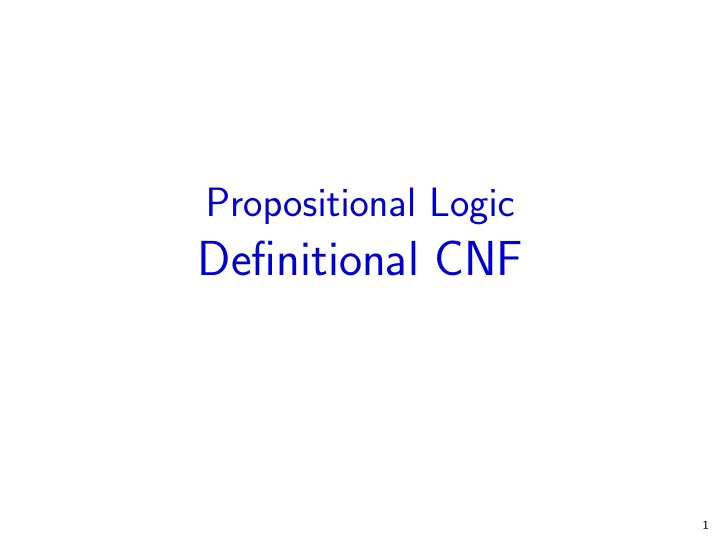

Propositional Logic Definitional CNF 1
Definitional CNF The definitional CNF of a formula is obtained in 2 steps: 1. Repeatedly replace a subformula G of the form ¬ A , A ∧ B or A ∨ B by a new atom A and conjoin A ↔ G . This replacement is not applied to the “definitions” A ↔ G but only to the (remains of the) original formula. 2. Translate all the subformulas A ↔ G into CNF. Example ¬ ( A 1 ∨ A 2 ) ∧ A 3 � ¬ A 4 ∧ A 3 ∧ ( A 4 ↔ ( A 1 ∨ A 2 )) � A 5 ∧ A 3 ∧ ( A 4 ↔ ( A 1 ∨ A 2 )) ∧ ( A 5 ↔ ¬ A 4 ) � A 5 ∧ A 3 ∧ CNF ( A 4 ↔ ( A 1 ∨ A 2 )) ∧ CNF ( A 5 ↔ ¬ A 4 ) 2
Definitional CNF: Complexity Let the initial formula have size n . 1. Each replacement step increases the size of the formula by a constant. There are at most as many replacement steps as subformulas, linearly many. 2. The conversion of each A ↔ G into CNF increases the size by a constant. There are only linearly many such subformulas. Thus the definitional CNF has size O ( n ). 3
Notation Definition The notation F [ G / A ] denotes the result of replacing all occurrences of the atom A in F by G . We pronounce it as “ F with G for A ”. Example ( A ∧ B )[( A → B ) / B ] = ( A ∧ ( A → B )) Definition The notation A [ v / A ] denotes a modified version of A that maps A to v and behaves like A otherwise: � v if A i = A ( A [ v / A ])( A i ) = A ( A i ) otherwise 4
Substitution Lemma Lemma A ( F [ G / A ]) = ( A [ A ( G ) / A ])( F ) Example A (( A 1 ∧ A 2 )[ G / A 2 ]) = ( A [ A ( G ) / A 2 ])( A 1 ∧ A 2 ) Proof by structural induction on F . 5
Definitional CNF: Correctness Each replacement step produces an equisatisfiable formula: Lemma Let A be an atom that does not occur in G. Then F [ G / A ] is equisatisfiable with F ∧ ( A ↔ G ) . Proof If F [ G / A ] is satisfiable by some assignment A , then by the Substitution Lemma, A ′ = A [ A ( G ) / A ] is a model of F . Moreover A ′ | = ( A ↔ G ) because A ′ ( A ) = A ( G ) and A ( G ) = A ′ ( G ) by the Coincidence Lemma (Exercise 1.2). Thus F ∧ ( A ↔ G ) is satsifiable (by A ′ ). Conversely we actually have F ∧ ( A ↔ G ) | = F [ G / A ]. Suppose A | = F ∧ ( A ↔ G ). This implies A ( A ) = A ( G ). Therefore A [ A ( G ) / A ] = A . Thus A ( F [ G / A ]) = ( A [ A ( G ) / A ])( F ) = A ( F ) = 1 by the Substitution Lemma. Does F [ G / A ] | = F ∧ ( A ↔ G ) hold? 6
Summary Theorem For every formula F of size n there is an equisatisfiable CNF formula G of size O ( n ) . Similarly it can be shown: Theorem For every formula F of size n there is an equivalid DNF formula G of size O ( n ) . 7
Validity of CNF Validity of formulas in CNF can be checked in linear time. A formula in CNF is valid iff all its disjunctions are valid. A disjunction is valid iff it contains both an atomic A and ¬ A as literals. Example Valid: ( A ∨ ¬ A ∨ B ) ∧ ( C ∨ ¬ C ) Not valid: ( A ∨ ¬ A ) ∧ ( ¬ A ∨ C ) 8
Satisfiability of DNF Satisfiability of formulas in DNF can be checked in linear time. A formula in DNF is satisfiable iff at least one of its conjunctions is satisfiable. A conjunction is satisfiable iff it does not contain both an atomic A and ¬ A as literals. Example Satisfiable: ( ¬ B ∧ A ∧ B ) ∨ ( ¬ A ∧ C ) Unsatisfiable: ( A ∧ ¬ A ∧ B ) ∨ ( C ∧ ¬ C ) 9
Satisfiability/validity of DNF and CNF Theorem Satisfiability of formulas in CNF is NP-complete. Theorem Validity of formulas in DNF is coNP-complete. 10
Recommend
More recommend